BUS 832: Leadership and Management - Sekar Group Case Analysis
VerifiedAdded on 2023/01/12
|14
|4099
|76
Case Study
AI Summary
This case study analyzes the Sekar Group, a family business founded in 1966, facing significant leadership and succession challenges as the founder prepares for retirement. The analysis explores the internal conflicts, including family feuds, nepotism, and the lack of a formal succession plan. The paper identifies challenges such as establishing qualified successors, separating family and business affairs, and ensuring the continuation of core values. The case proposes alternative solutions, including the implementation of a structured succession plan, ethical leadership, and the separation of family and business management. The analysis also suggests strategies for managing change and balancing family control with the inclusion of non-family employees. The study emphasizes the importance of ethical leadership, strategic planning, and organizational change to ensure the long-term success of the Sekar Group.
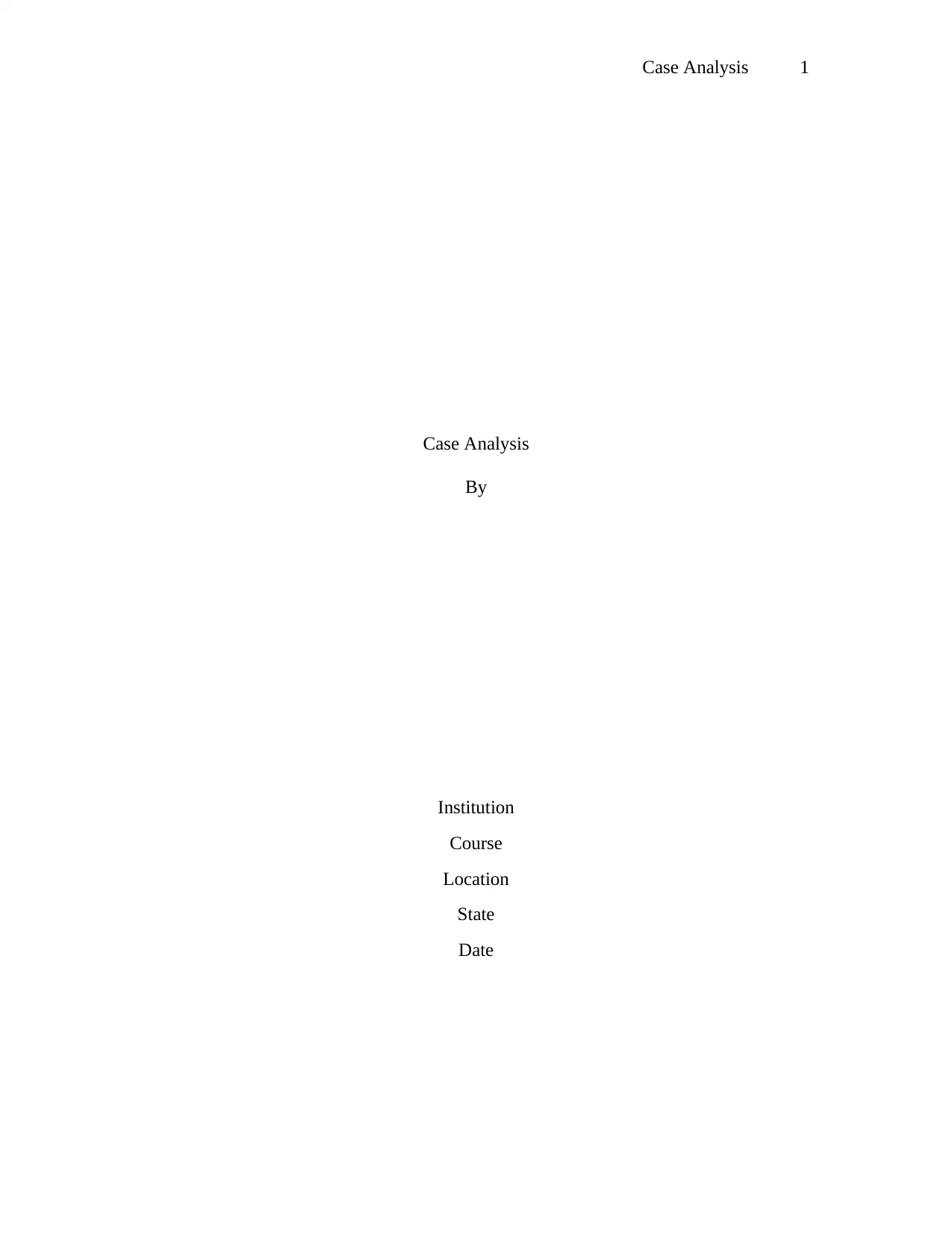
Case Analysis 1
Case Analysis
By
Institution
Course
Location
State
Date
Case Analysis
By
Institution
Course
Location
State
Date
Paraphrase This Document
Need a fresh take? Get an instant paraphrase of this document with our AI Paraphraser
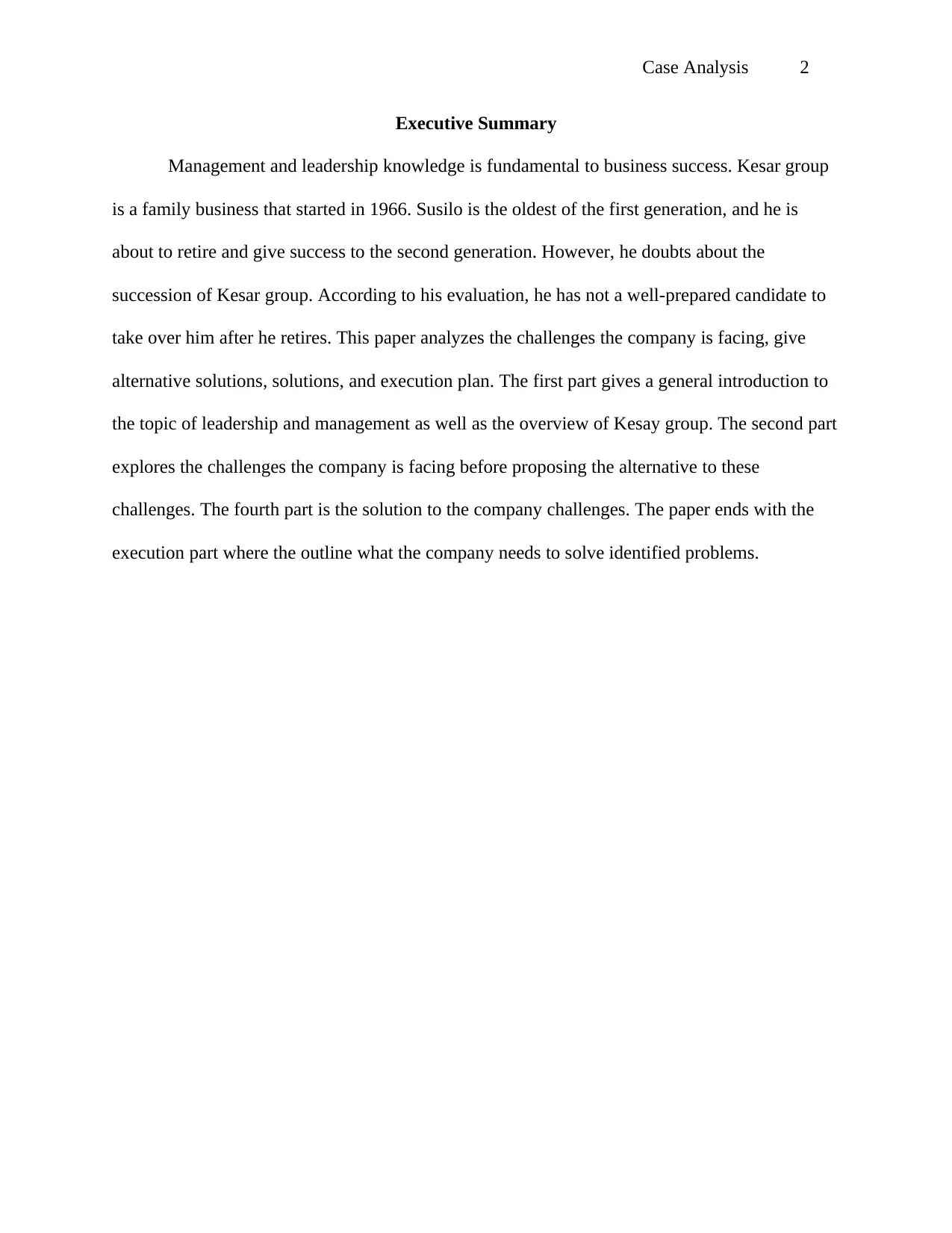
Case Analysis 2
Executive Summary
Management and leadership knowledge is fundamental to business success. Kesar group
is a family business that started in 1966. Susilo is the oldest of the first generation, and he is
about to retire and give success to the second generation. However, he doubts about the
succession of Kesar group. According to his evaluation, he has not a well-prepared candidate to
take over him after he retires. This paper analyzes the challenges the company is facing, give
alternative solutions, solutions, and execution plan. The first part gives a general introduction to
the topic of leadership and management as well as the overview of Kesay group. The second part
explores the challenges the company is facing before proposing the alternative to these
challenges. The fourth part is the solution to the company challenges. The paper ends with the
execution part where the outline what the company needs to solve identified problems.
Executive Summary
Management and leadership knowledge is fundamental to business success. Kesar group
is a family business that started in 1966. Susilo is the oldest of the first generation, and he is
about to retire and give success to the second generation. However, he doubts about the
succession of Kesar group. According to his evaluation, he has not a well-prepared candidate to
take over him after he retires. This paper analyzes the challenges the company is facing, give
alternative solutions, solutions, and execution plan. The first part gives a general introduction to
the topic of leadership and management as well as the overview of Kesay group. The second part
explores the challenges the company is facing before proposing the alternative to these
challenges. The fourth part is the solution to the company challenges. The paper ends with the
execution part where the outline what the company needs to solve identified problems.
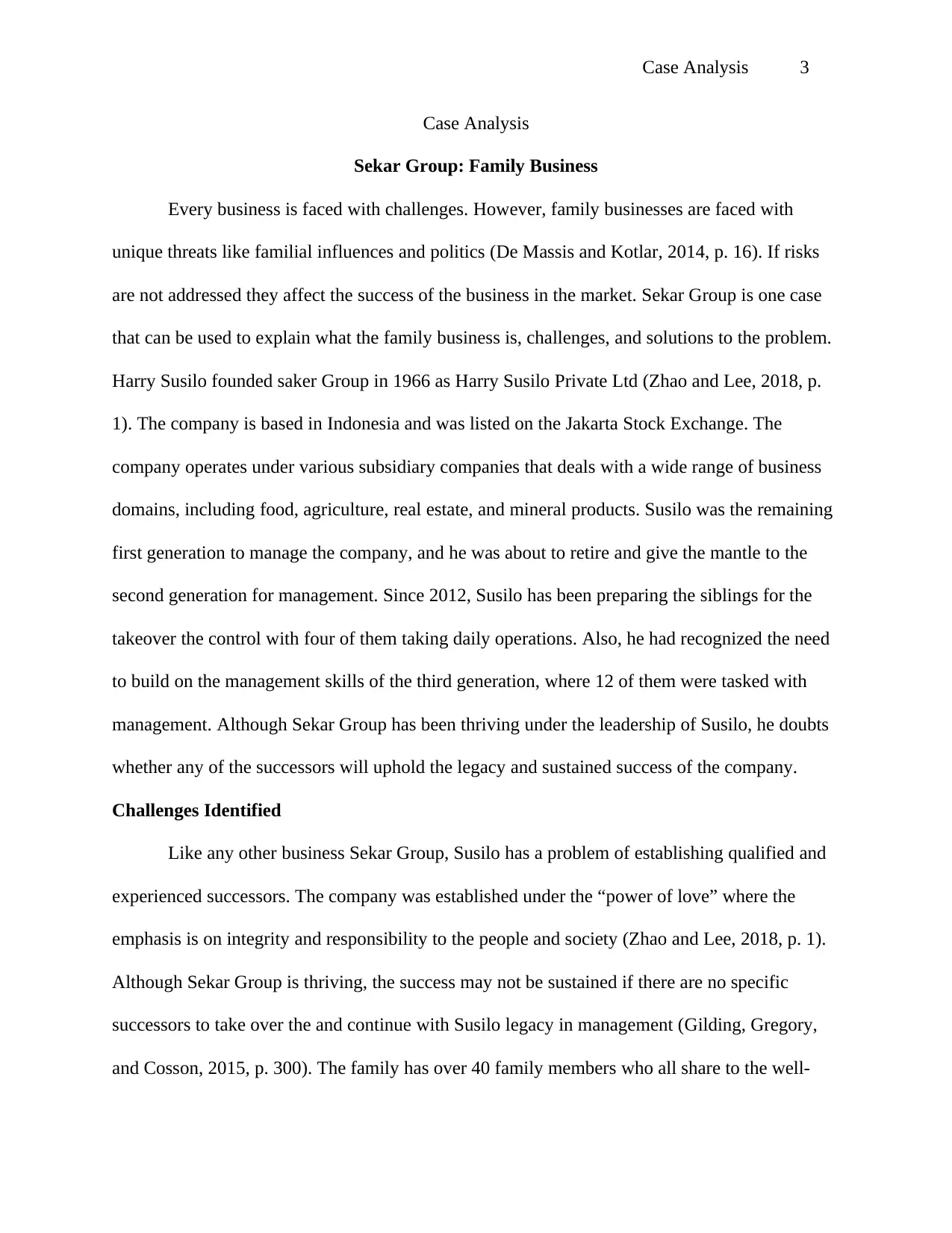
Case Analysis 3
Case Analysis
Sekar Group: Family Business
Every business is faced with challenges. However, family businesses are faced with
unique threats like familial influences and politics (De Massis and Kotlar, 2014, p. 16). If risks
are not addressed they affect the success of the business in the market. Sekar Group is one case
that can be used to explain what the family business is, challenges, and solutions to the problem.
Harry Susilo founded saker Group in 1966 as Harry Susilo Private Ltd (Zhao and Lee, 2018, p.
1). The company is based in Indonesia and was listed on the Jakarta Stock Exchange. The
company operates under various subsidiary companies that deals with a wide range of business
domains, including food, agriculture, real estate, and mineral products. Susilo was the remaining
first generation to manage the company, and he was about to retire and give the mantle to the
second generation for management. Since 2012, Susilo has been preparing the siblings for the
takeover the control with four of them taking daily operations. Also, he had recognized the need
to build on the management skills of the third generation, where 12 of them were tasked with
management. Although Sekar Group has been thriving under the leadership of Susilo, he doubts
whether any of the successors will uphold the legacy and sustained success of the company.
Challenges Identified
Like any other business Sekar Group, Susilo has a problem of establishing qualified and
experienced successors. The company was established under the “power of love” where the
emphasis is on integrity and responsibility to the people and society (Zhao and Lee, 2018, p. 1).
Although Sekar Group is thriving, the success may not be sustained if there are no specific
successors to take over the and continue with Susilo legacy in management (Gilding, Gregory,
and Cosson, 2015, p. 300). The family has over 40 family members who all share to the well-
Case Analysis
Sekar Group: Family Business
Every business is faced with challenges. However, family businesses are faced with
unique threats like familial influences and politics (De Massis and Kotlar, 2014, p. 16). If risks
are not addressed they affect the success of the business in the market. Sekar Group is one case
that can be used to explain what the family business is, challenges, and solutions to the problem.
Harry Susilo founded saker Group in 1966 as Harry Susilo Private Ltd (Zhao and Lee, 2018, p.
1). The company is based in Indonesia and was listed on the Jakarta Stock Exchange. The
company operates under various subsidiary companies that deals with a wide range of business
domains, including food, agriculture, real estate, and mineral products. Susilo was the remaining
first generation to manage the company, and he was about to retire and give the mantle to the
second generation for management. Since 2012, Susilo has been preparing the siblings for the
takeover the control with four of them taking daily operations. Also, he had recognized the need
to build on the management skills of the third generation, where 12 of them were tasked with
management. Although Sekar Group has been thriving under the leadership of Susilo, he doubts
whether any of the successors will uphold the legacy and sustained success of the company.
Challenges Identified
Like any other business Sekar Group, Susilo has a problem of establishing qualified and
experienced successors. The company was established under the “power of love” where the
emphasis is on integrity and responsibility to the people and society (Zhao and Lee, 2018, p. 1).
Although Sekar Group is thriving, the success may not be sustained if there are no specific
successors to take over the and continue with Susilo legacy in management (Gilding, Gregory,
and Cosson, 2015, p. 300). The family has over 40 family members who all share to the well-
⊘ This is a preview!⊘
Do you want full access?
Subscribe today to unlock all pages.

Trusted by 1+ million students worldwide
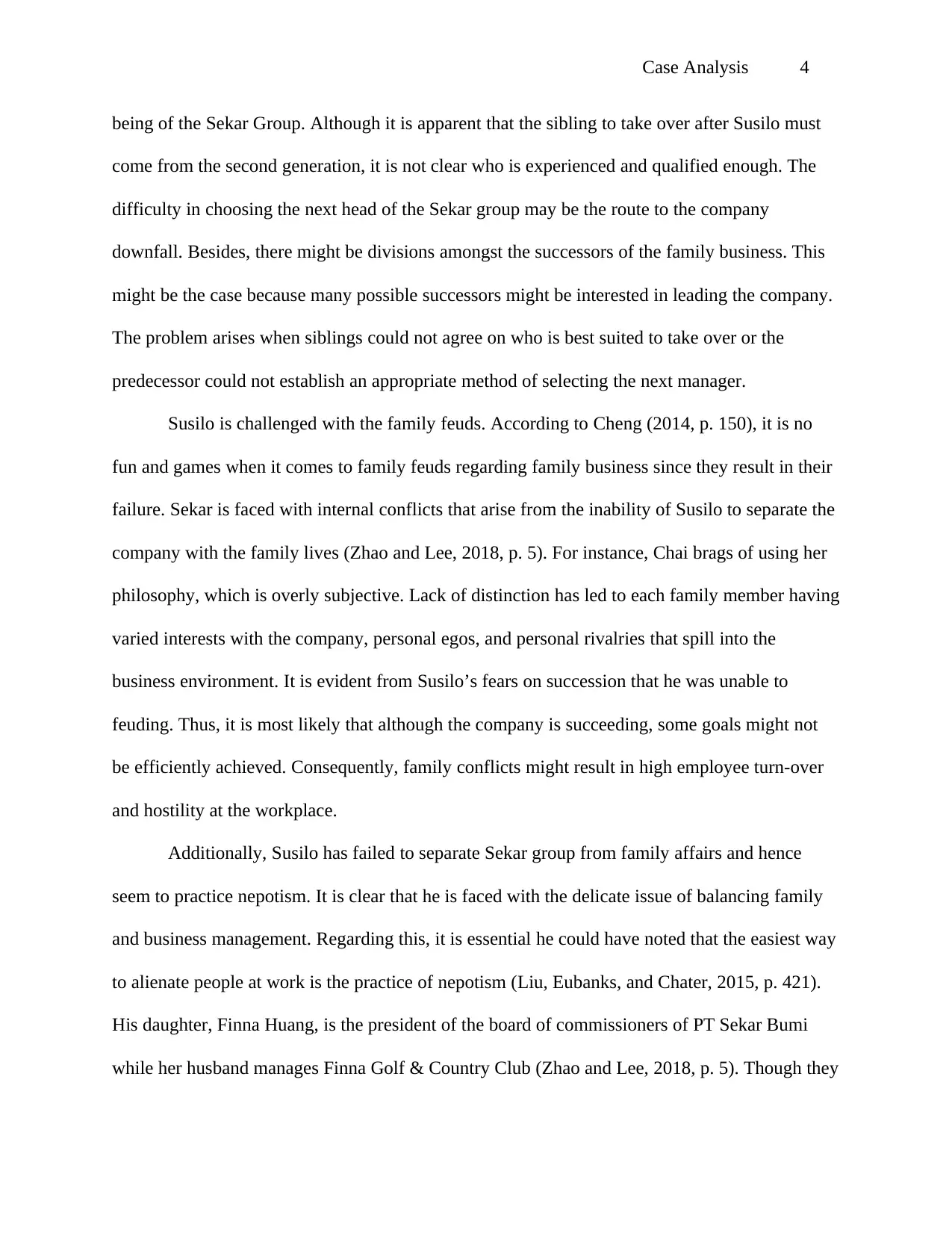
Case Analysis 4
being of the Sekar Group. Although it is apparent that the sibling to take over after Susilo must
come from the second generation, it is not clear who is experienced and qualified enough. The
difficulty in choosing the next head of the Sekar group may be the route to the company
downfall. Besides, there might be divisions amongst the successors of the family business. This
might be the case because many possible successors might be interested in leading the company.
The problem arises when siblings could not agree on who is best suited to take over or the
predecessor could not establish an appropriate method of selecting the next manager.
Susilo is challenged with the family feuds. According to Cheng (2014, p. 150), it is no
fun and games when it comes to family feuds regarding family business since they result in their
failure. Sekar is faced with internal conflicts that arise from the inability of Susilo to separate the
company with the family lives (Zhao and Lee, 2018, p. 5). For instance, Chai brags of using her
philosophy, which is overly subjective. Lack of distinction has led to each family member having
varied interests with the company, personal egos, and personal rivalries that spill into the
business environment. It is evident from Susilo’s fears on succession that he was unable to
feuding. Thus, it is most likely that although the company is succeeding, some goals might not
be efficiently achieved. Consequently, family conflicts might result in high employee turn-over
and hostility at the workplace.
Additionally, Susilo has failed to separate Sekar group from family affairs and hence
seem to practice nepotism. It is clear that he is faced with the delicate issue of balancing family
and business management. Regarding this, it is essential he could have noted that the easiest way
to alienate people at work is the practice of nepotism (Liu, Eubanks, and Chater, 2015, p. 421).
His daughter, Finna Huang, is the president of the board of commissioners of PT Sekar Bumi
while her husband manages Finna Golf & Country Club (Zhao and Lee, 2018, p. 5). Though they
being of the Sekar Group. Although it is apparent that the sibling to take over after Susilo must
come from the second generation, it is not clear who is experienced and qualified enough. The
difficulty in choosing the next head of the Sekar group may be the route to the company
downfall. Besides, there might be divisions amongst the successors of the family business. This
might be the case because many possible successors might be interested in leading the company.
The problem arises when siblings could not agree on who is best suited to take over or the
predecessor could not establish an appropriate method of selecting the next manager.
Susilo is challenged with the family feuds. According to Cheng (2014, p. 150), it is no
fun and games when it comes to family feuds regarding family business since they result in their
failure. Sekar is faced with internal conflicts that arise from the inability of Susilo to separate the
company with the family lives (Zhao and Lee, 2018, p. 5). For instance, Chai brags of using her
philosophy, which is overly subjective. Lack of distinction has led to each family member having
varied interests with the company, personal egos, and personal rivalries that spill into the
business environment. It is evident from Susilo’s fears on succession that he was unable to
feuding. Thus, it is most likely that although the company is succeeding, some goals might not
be efficiently achieved. Consequently, family conflicts might result in high employee turn-over
and hostility at the workplace.
Additionally, Susilo has failed to separate Sekar group from family affairs and hence
seem to practice nepotism. It is clear that he is faced with the delicate issue of balancing family
and business management. Regarding this, it is essential he could have noted that the easiest way
to alienate people at work is the practice of nepotism (Liu, Eubanks, and Chater, 2015, p. 421).
His daughter, Finna Huang, is the president of the board of commissioners of PT Sekar Bumi
while her husband manages Finna Golf & Country Club (Zhao and Lee, 2018, p. 5). Though they
Paraphrase This Document
Need a fresh take? Get an instant paraphrase of this document with our AI Paraphraser
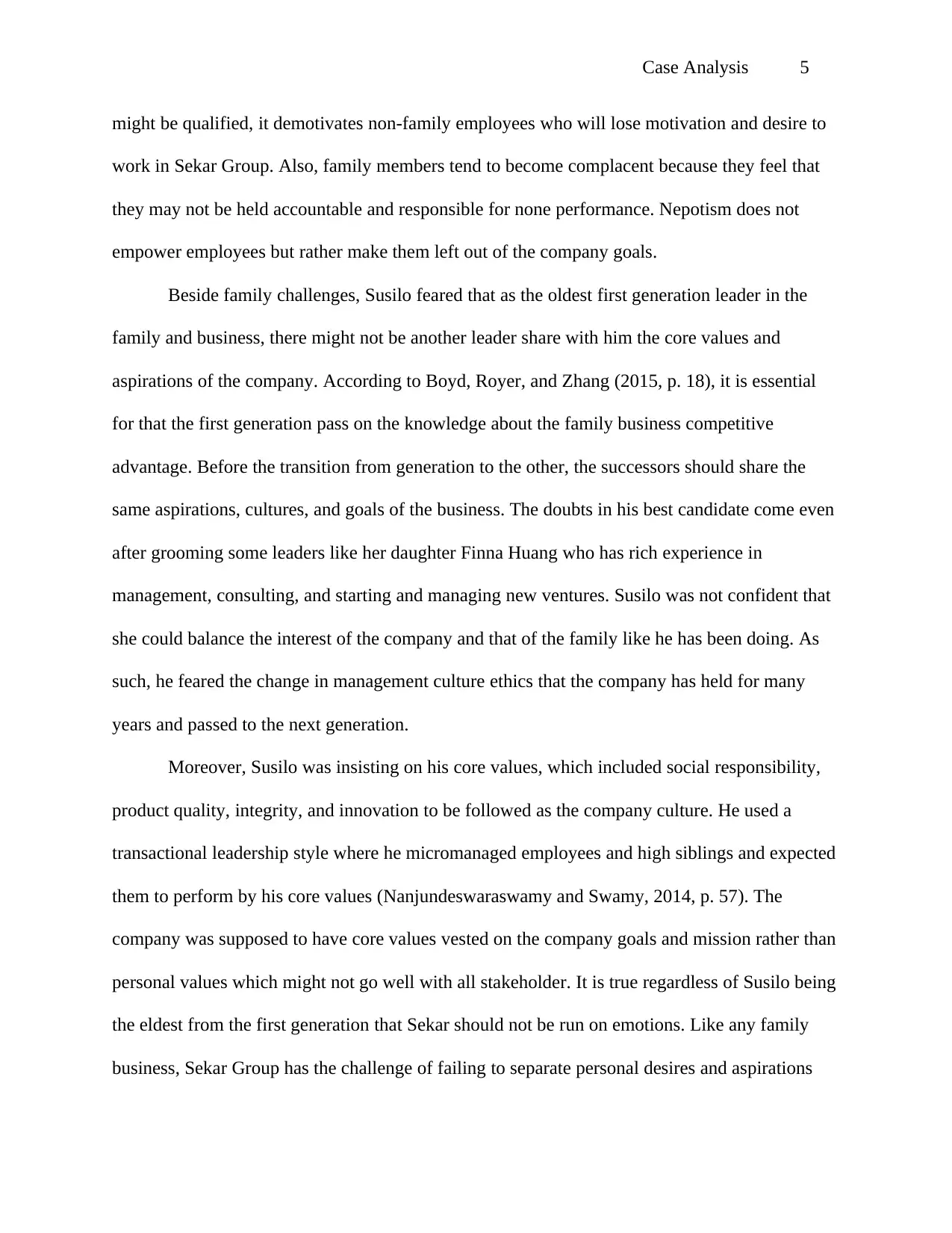
Case Analysis 5
might be qualified, it demotivates non-family employees who will lose motivation and desire to
work in Sekar Group. Also, family members tend to become complacent because they feel that
they may not be held accountable and responsible for none performance. Nepotism does not
empower employees but rather make them left out of the company goals.
Beside family challenges, Susilo feared that as the oldest first generation leader in the
family and business, there might not be another leader share with him the core values and
aspirations of the company. According to Boyd, Royer, and Zhang (2015, p. 18), it is essential
for that the first generation pass on the knowledge about the family business competitive
advantage. Before the transition from generation to the other, the successors should share the
same aspirations, cultures, and goals of the business. The doubts in his best candidate come even
after grooming some leaders like her daughter Finna Huang who has rich experience in
management, consulting, and starting and managing new ventures. Susilo was not confident that
she could balance the interest of the company and that of the family like he has been doing. As
such, he feared the change in management culture ethics that the company has held for many
years and passed to the next generation.
Moreover, Susilo was insisting on his core values, which included social responsibility,
product quality, integrity, and innovation to be followed as the company culture. He used a
transactional leadership style where he micromanaged employees and high siblings and expected
them to perform by his core values (Nanjundeswaraswamy and Swamy, 2014, p. 57). The
company was supposed to have core values vested on the company goals and mission rather than
personal values which might not go well with all stakeholder. It is true regardless of Susilo being
the eldest from the first generation that Sekar should not be run on emotions. Like any family
business, Sekar Group has the challenge of failing to separate personal desires and aspirations
might be qualified, it demotivates non-family employees who will lose motivation and desire to
work in Sekar Group. Also, family members tend to become complacent because they feel that
they may not be held accountable and responsible for none performance. Nepotism does not
empower employees but rather make them left out of the company goals.
Beside family challenges, Susilo feared that as the oldest first generation leader in the
family and business, there might not be another leader share with him the core values and
aspirations of the company. According to Boyd, Royer, and Zhang (2015, p. 18), it is essential
for that the first generation pass on the knowledge about the family business competitive
advantage. Before the transition from generation to the other, the successors should share the
same aspirations, cultures, and goals of the business. The doubts in his best candidate come even
after grooming some leaders like her daughter Finna Huang who has rich experience in
management, consulting, and starting and managing new ventures. Susilo was not confident that
she could balance the interest of the company and that of the family like he has been doing. As
such, he feared the change in management culture ethics that the company has held for many
years and passed to the next generation.
Moreover, Susilo was insisting on his core values, which included social responsibility,
product quality, integrity, and innovation to be followed as the company culture. He used a
transactional leadership style where he micromanaged employees and high siblings and expected
them to perform by his core values (Nanjundeswaraswamy and Swamy, 2014, p. 57). The
company was supposed to have core values vested on the company goals and mission rather than
personal values which might not go well with all stakeholder. It is true regardless of Susilo being
the eldest from the first generation that Sekar should not be run on emotions. Like any family
business, Sekar Group has the challenge of failing to separate personal desires and aspirations
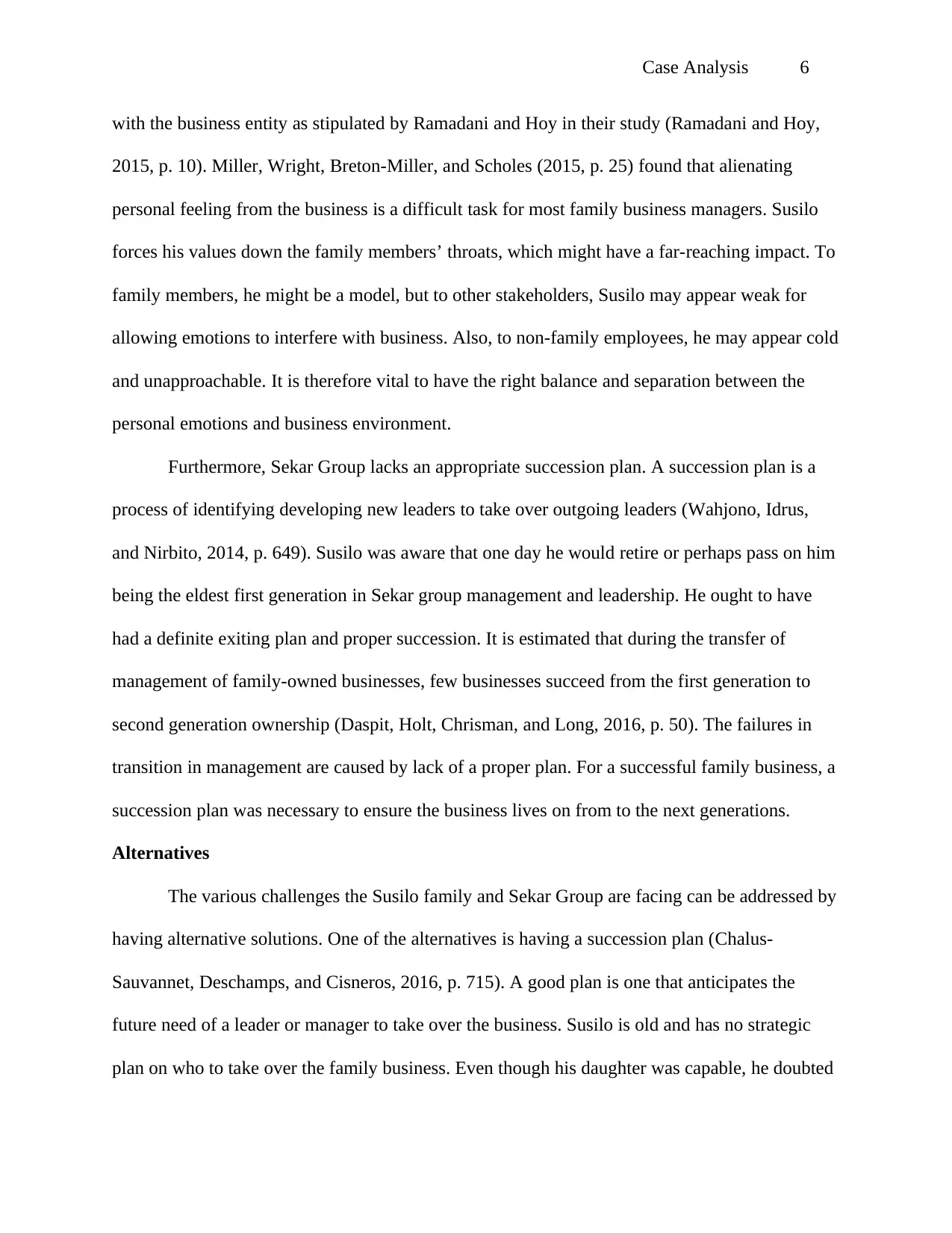
Case Analysis 6
with the business entity as stipulated by Ramadani and Hoy in their study (Ramadani and Hoy,
2015, p. 10). Miller, Wright, Breton-Miller, and Scholes (2015, p. 25) found that alienating
personal feeling from the business is a difficult task for most family business managers. Susilo
forces his values down the family members’ throats, which might have a far-reaching impact. To
family members, he might be a model, but to other stakeholders, Susilo may appear weak for
allowing emotions to interfere with business. Also, to non-family employees, he may appear cold
and unapproachable. It is therefore vital to have the right balance and separation between the
personal emotions and business environment.
Furthermore, Sekar Group lacks an appropriate succession plan. A succession plan is a
process of identifying developing new leaders to take over outgoing leaders (Wahjono, Idrus,
and Nirbito, 2014, p. 649). Susilo was aware that one day he would retire or perhaps pass on him
being the eldest first generation in Sekar group management and leadership. He ought to have
had a definite exiting plan and proper succession. It is estimated that during the transfer of
management of family-owned businesses, few businesses succeed from the first generation to
second generation ownership (Daspit, Holt, Chrisman, and Long, 2016, p. 50). The failures in
transition in management are caused by lack of a proper plan. For a successful family business, a
succession plan was necessary to ensure the business lives on from to the next generations.
Alternatives
The various challenges the Susilo family and Sekar Group are facing can be addressed by
having alternative solutions. One of the alternatives is having a succession plan (Chalus‐
Sauvannet, Deschamps, and Cisneros, 2016, p. 715). A good plan is one that anticipates the
future need of a leader or manager to take over the business. Susilo is old and has no strategic
plan on who to take over the family business. Even though his daughter was capable, he doubted
with the business entity as stipulated by Ramadani and Hoy in their study (Ramadani and Hoy,
2015, p. 10). Miller, Wright, Breton-Miller, and Scholes (2015, p. 25) found that alienating
personal feeling from the business is a difficult task for most family business managers. Susilo
forces his values down the family members’ throats, which might have a far-reaching impact. To
family members, he might be a model, but to other stakeholders, Susilo may appear weak for
allowing emotions to interfere with business. Also, to non-family employees, he may appear cold
and unapproachable. It is therefore vital to have the right balance and separation between the
personal emotions and business environment.
Furthermore, Sekar Group lacks an appropriate succession plan. A succession plan is a
process of identifying developing new leaders to take over outgoing leaders (Wahjono, Idrus,
and Nirbito, 2014, p. 649). Susilo was aware that one day he would retire or perhaps pass on him
being the eldest first generation in Sekar group management and leadership. He ought to have
had a definite exiting plan and proper succession. It is estimated that during the transfer of
management of family-owned businesses, few businesses succeed from the first generation to
second generation ownership (Daspit, Holt, Chrisman, and Long, 2016, p. 50). The failures in
transition in management are caused by lack of a proper plan. For a successful family business, a
succession plan was necessary to ensure the business lives on from to the next generations.
Alternatives
The various challenges the Susilo family and Sekar Group are facing can be addressed by
having alternative solutions. One of the alternatives is having a succession plan (Chalus‐
Sauvannet, Deschamps, and Cisneros, 2016, p. 715). A good plan is one that anticipates the
future need of a leader or manager to take over the business. Susilo is old and has no strategic
plan on who to take over the family business. Even though his daughter was capable, he doubted
⊘ This is a preview!⊘
Do you want full access?
Subscribe today to unlock all pages.

Trusted by 1+ million students worldwide
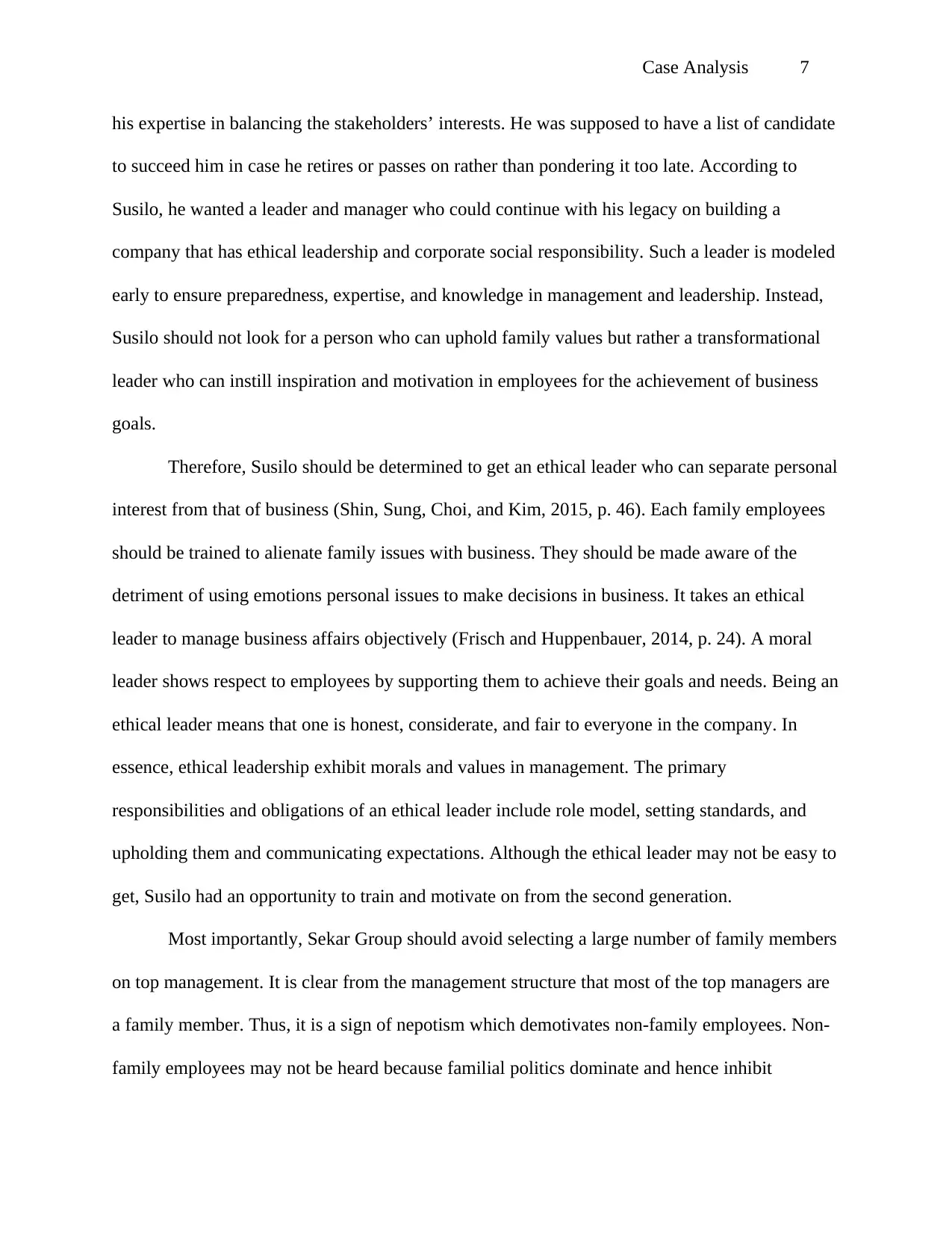
Case Analysis 7
his expertise in balancing the stakeholders’ interests. He was supposed to have a list of candidate
to succeed him in case he retires or passes on rather than pondering it too late. According to
Susilo, he wanted a leader and manager who could continue with his legacy on building a
company that has ethical leadership and corporate social responsibility. Such a leader is modeled
early to ensure preparedness, expertise, and knowledge in management and leadership. Instead,
Susilo should not look for a person who can uphold family values but rather a transformational
leader who can instill inspiration and motivation in employees for the achievement of business
goals.
Therefore, Susilo should be determined to get an ethical leader who can separate personal
interest from that of business (Shin, Sung, Choi, and Kim, 2015, p. 46). Each family employees
should be trained to alienate family issues with business. They should be made aware of the
detriment of using emotions personal issues to make decisions in business. It takes an ethical
leader to manage business affairs objectively (Frisch and Huppenbauer, 2014, p. 24). A moral
leader shows respect to employees by supporting them to achieve their goals and needs. Being an
ethical leader means that one is honest, considerate, and fair to everyone in the company. In
essence, ethical leadership exhibit morals and values in management. The primary
responsibilities and obligations of an ethical leader include role model, setting standards, and
upholding them and communicating expectations. Although the ethical leader may not be easy to
get, Susilo had an opportunity to train and motivate on from the second generation.
Most importantly, Sekar Group should avoid selecting a large number of family members
on top management. It is clear from the management structure that most of the top managers are
a family member. Thus, it is a sign of nepotism which demotivates non-family employees. Non-
family employees may not be heard because familial politics dominate and hence inhibit
his expertise in balancing the stakeholders’ interests. He was supposed to have a list of candidate
to succeed him in case he retires or passes on rather than pondering it too late. According to
Susilo, he wanted a leader and manager who could continue with his legacy on building a
company that has ethical leadership and corporate social responsibility. Such a leader is modeled
early to ensure preparedness, expertise, and knowledge in management and leadership. Instead,
Susilo should not look for a person who can uphold family values but rather a transformational
leader who can instill inspiration and motivation in employees for the achievement of business
goals.
Therefore, Susilo should be determined to get an ethical leader who can separate personal
interest from that of business (Shin, Sung, Choi, and Kim, 2015, p. 46). Each family employees
should be trained to alienate family issues with business. They should be made aware of the
detriment of using emotions personal issues to make decisions in business. It takes an ethical
leader to manage business affairs objectively (Frisch and Huppenbauer, 2014, p. 24). A moral
leader shows respect to employees by supporting them to achieve their goals and needs. Being an
ethical leader means that one is honest, considerate, and fair to everyone in the company. In
essence, ethical leadership exhibit morals and values in management. The primary
responsibilities and obligations of an ethical leader include role model, setting standards, and
upholding them and communicating expectations. Although the ethical leader may not be easy to
get, Susilo had an opportunity to train and motivate on from the second generation.
Most importantly, Sekar Group should avoid selecting a large number of family members
on top management. It is clear from the management structure that most of the top managers are
a family member. Thus, it is a sign of nepotism which demotivates non-family employees. Non-
family employees may not be heard because familial politics dominate and hence inhibit
Paraphrase This Document
Need a fresh take? Get an instant paraphrase of this document with our AI Paraphraser
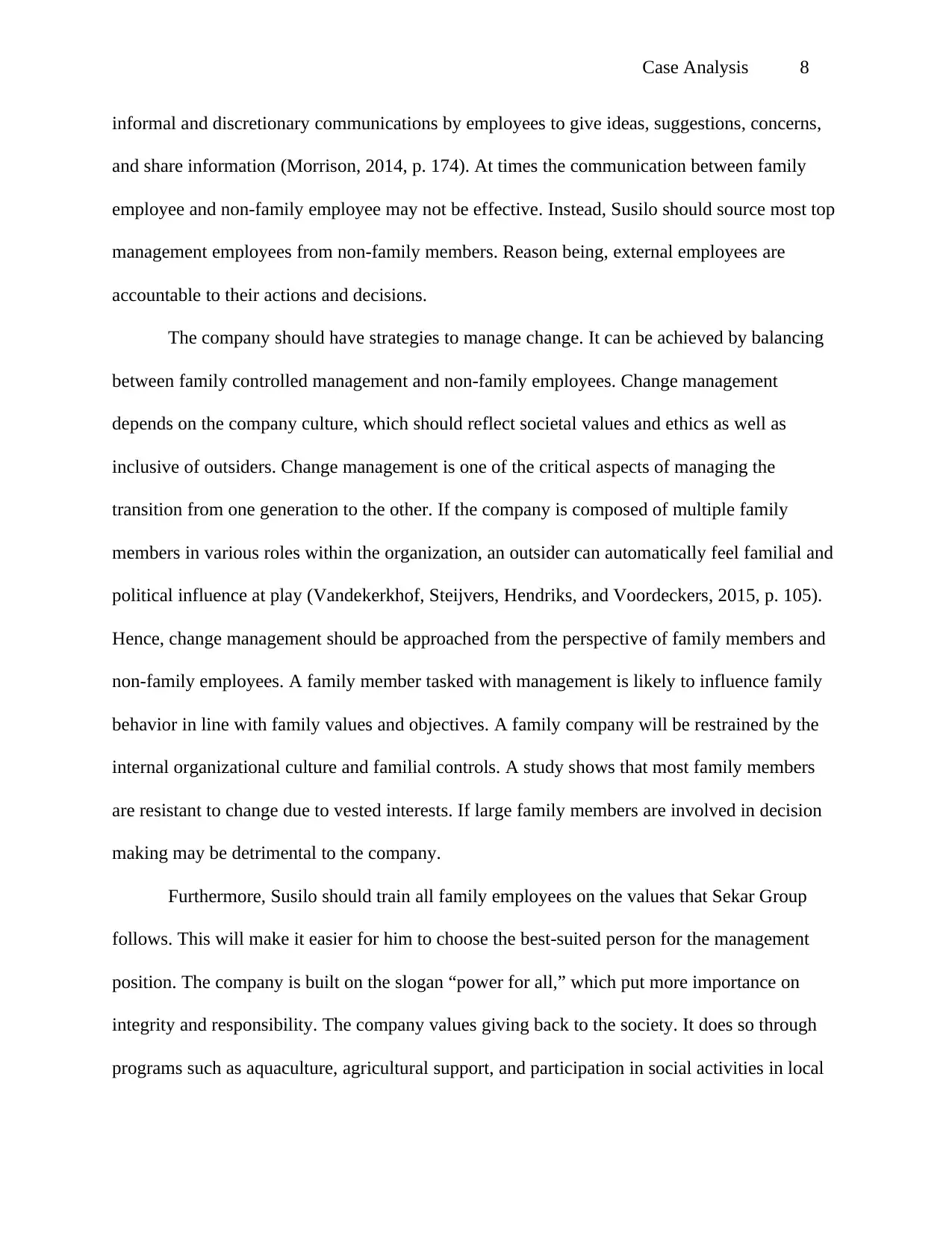
Case Analysis 8
informal and discretionary communications by employees to give ideas, suggestions, concerns,
and share information (Morrison, 2014, p. 174). At times the communication between family
employee and non-family employee may not be effective. Instead, Susilo should source most top
management employees from non-family members. Reason being, external employees are
accountable to their actions and decisions.
The company should have strategies to manage change. It can be achieved by balancing
between family controlled management and non-family employees. Change management
depends on the company culture, which should reflect societal values and ethics as well as
inclusive of outsiders. Change management is one of the critical aspects of managing the
transition from one generation to the other. If the company is composed of multiple family
members in various roles within the organization, an outsider can automatically feel familial and
political influence at play (Vandekerkhof, Steijvers, Hendriks, and Voordeckers, 2015, p. 105).
Hence, change management should be approached from the perspective of family members and
non-family employees. A family member tasked with management is likely to influence family
behavior in line with family values and objectives. A family company will be restrained by the
internal organizational culture and familial controls. A study shows that most family members
are resistant to change due to vested interests. If large family members are involved in decision
making may be detrimental to the company.
Furthermore, Susilo should train all family employees on the values that Sekar Group
follows. This will make it easier for him to choose the best-suited person for the management
position. The company is built on the slogan “power for all,” which put more importance on
integrity and responsibility. The company values giving back to the society. It does so through
programs such as aquaculture, agricultural support, and participation in social activities in local
informal and discretionary communications by employees to give ideas, suggestions, concerns,
and share information (Morrison, 2014, p. 174). At times the communication between family
employee and non-family employee may not be effective. Instead, Susilo should source most top
management employees from non-family members. Reason being, external employees are
accountable to their actions and decisions.
The company should have strategies to manage change. It can be achieved by balancing
between family controlled management and non-family employees. Change management
depends on the company culture, which should reflect societal values and ethics as well as
inclusive of outsiders. Change management is one of the critical aspects of managing the
transition from one generation to the other. If the company is composed of multiple family
members in various roles within the organization, an outsider can automatically feel familial and
political influence at play (Vandekerkhof, Steijvers, Hendriks, and Voordeckers, 2015, p. 105).
Hence, change management should be approached from the perspective of family members and
non-family employees. A family member tasked with management is likely to influence family
behavior in line with family values and objectives. A family company will be restrained by the
internal organizational culture and familial controls. A study shows that most family members
are resistant to change due to vested interests. If large family members are involved in decision
making may be detrimental to the company.
Furthermore, Susilo should train all family employees on the values that Sekar Group
follows. This will make it easier for him to choose the best-suited person for the management
position. The company is built on the slogan “power for all,” which put more importance on
integrity and responsibility. The company values giving back to the society. It does so through
programs such as aquaculture, agricultural support, and participation in social activities in local
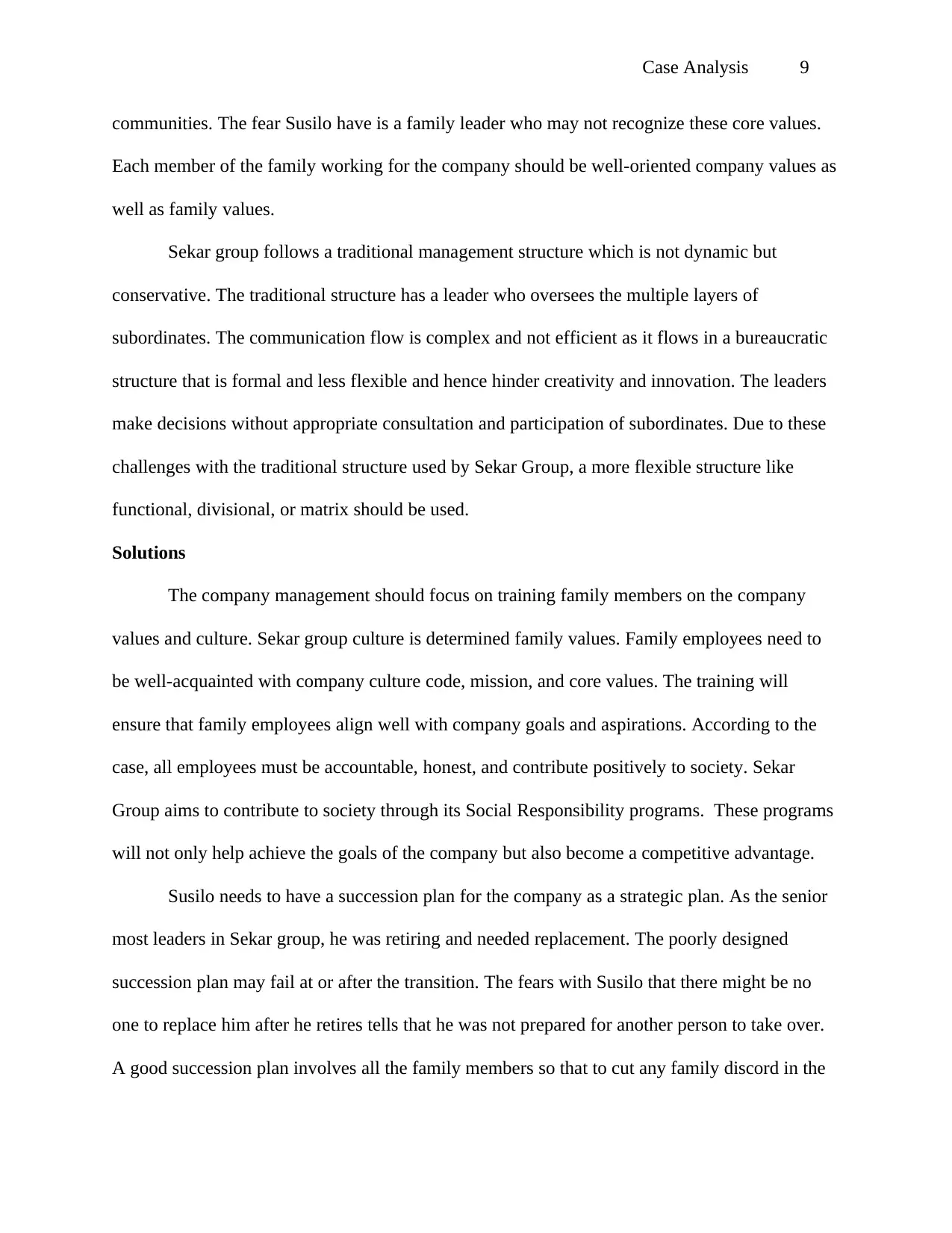
Case Analysis 9
communities. The fear Susilo have is a family leader who may not recognize these core values.
Each member of the family working for the company should be well-oriented company values as
well as family values.
Sekar group follows a traditional management structure which is not dynamic but
conservative. The traditional structure has a leader who oversees the multiple layers of
subordinates. The communication flow is complex and not efficient as it flows in a bureaucratic
structure that is formal and less flexible and hence hinder creativity and innovation. The leaders
make decisions without appropriate consultation and participation of subordinates. Due to these
challenges with the traditional structure used by Sekar Group, a more flexible structure like
functional, divisional, or matrix should be used.
Solutions
The company management should focus on training family members on the company
values and culture. Sekar group culture is determined family values. Family employees need to
be well-acquainted with company culture code, mission, and core values. The training will
ensure that family employees align well with company goals and aspirations. According to the
case, all employees must be accountable, honest, and contribute positively to society. Sekar
Group aims to contribute to society through its Social Responsibility programs. These programs
will not only help achieve the goals of the company but also become a competitive advantage.
Susilo needs to have a succession plan for the company as a strategic plan. As the senior
most leaders in Sekar group, he was retiring and needed replacement. The poorly designed
succession plan may fail at or after the transition. The fears with Susilo that there might be no
one to replace him after he retires tells that he was not prepared for another person to take over.
A good succession plan involves all the family members so that to cut any family discord in the
communities. The fear Susilo have is a family leader who may not recognize these core values.
Each member of the family working for the company should be well-oriented company values as
well as family values.
Sekar group follows a traditional management structure which is not dynamic but
conservative. The traditional structure has a leader who oversees the multiple layers of
subordinates. The communication flow is complex and not efficient as it flows in a bureaucratic
structure that is formal and less flexible and hence hinder creativity and innovation. The leaders
make decisions without appropriate consultation and participation of subordinates. Due to these
challenges with the traditional structure used by Sekar Group, a more flexible structure like
functional, divisional, or matrix should be used.
Solutions
The company management should focus on training family members on the company
values and culture. Sekar group culture is determined family values. Family employees need to
be well-acquainted with company culture code, mission, and core values. The training will
ensure that family employees align well with company goals and aspirations. According to the
case, all employees must be accountable, honest, and contribute positively to society. Sekar
Group aims to contribute to society through its Social Responsibility programs. These programs
will not only help achieve the goals of the company but also become a competitive advantage.
Susilo needs to have a succession plan for the company as a strategic plan. As the senior
most leaders in Sekar group, he was retiring and needed replacement. The poorly designed
succession plan may fail at or after the transition. The fears with Susilo that there might be no
one to replace him after he retires tells that he was not prepared for another person to take over.
A good succession plan involves all the family members so that to cut any family discord in the
⊘ This is a preview!⊘
Do you want full access?
Subscribe today to unlock all pages.

Trusted by 1+ million students worldwide
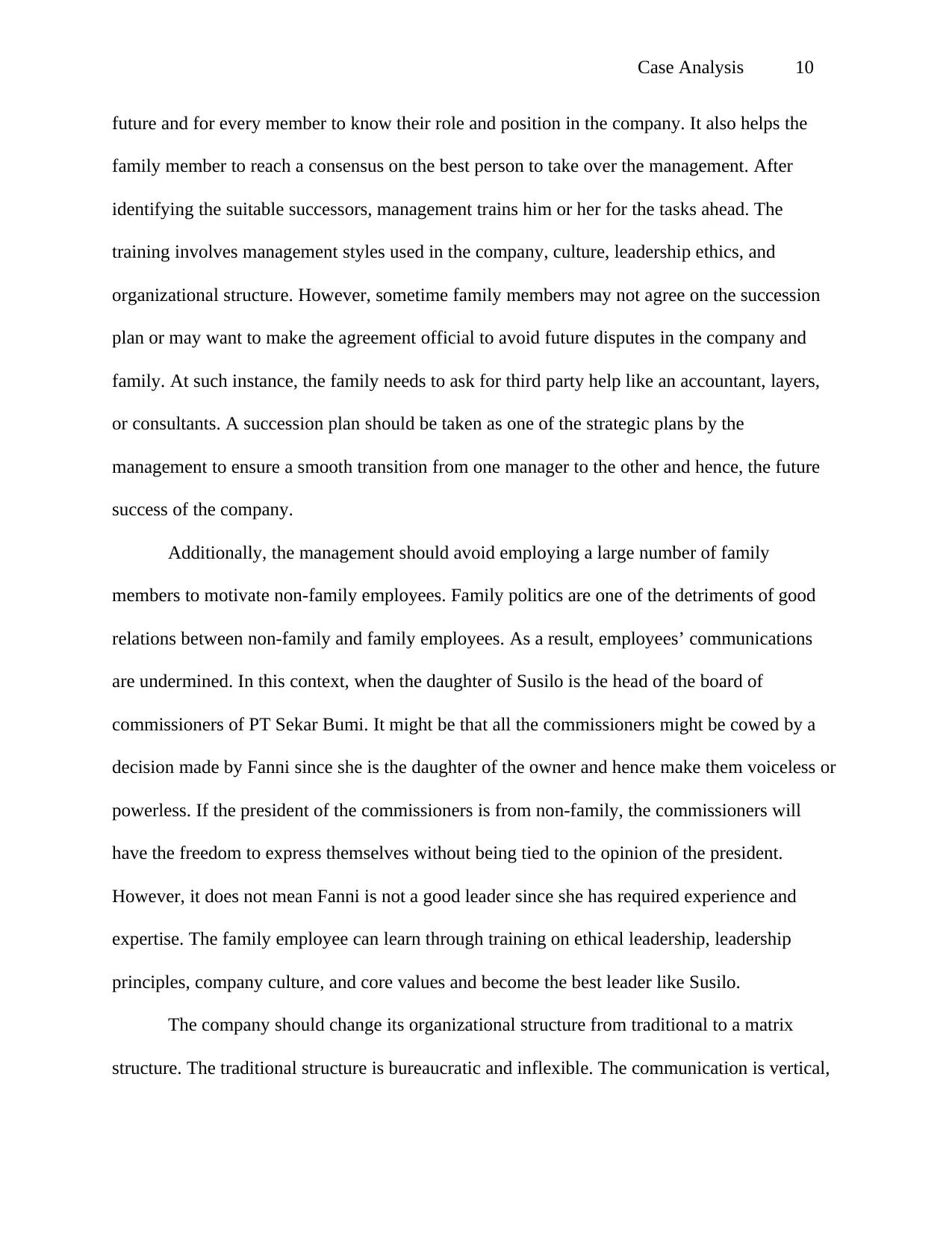
Case Analysis 10
future and for every member to know their role and position in the company. It also helps the
family member to reach a consensus on the best person to take over the management. After
identifying the suitable successors, management trains him or her for the tasks ahead. The
training involves management styles used in the company, culture, leadership ethics, and
organizational structure. However, sometime family members may not agree on the succession
plan or may want to make the agreement official to avoid future disputes in the company and
family. At such instance, the family needs to ask for third party help like an accountant, layers,
or consultants. A succession plan should be taken as one of the strategic plans by the
management to ensure a smooth transition from one manager to the other and hence, the future
success of the company.
Additionally, the management should avoid employing a large number of family
members to motivate non-family employees. Family politics are one of the detriments of good
relations between non-family and family employees. As a result, employees’ communications
are undermined. In this context, when the daughter of Susilo is the head of the board of
commissioners of PT Sekar Bumi. It might be that all the commissioners might be cowed by a
decision made by Fanni since she is the daughter of the owner and hence make them voiceless or
powerless. If the president of the commissioners is from non-family, the commissioners will
have the freedom to express themselves without being tied to the opinion of the president.
However, it does not mean Fanni is not a good leader since she has required experience and
expertise. The family employee can learn through training on ethical leadership, leadership
principles, company culture, and core values and become the best leader like Susilo.
The company should change its organizational structure from traditional to a matrix
structure. The traditional structure is bureaucratic and inflexible. The communication is vertical,
future and for every member to know their role and position in the company. It also helps the
family member to reach a consensus on the best person to take over the management. After
identifying the suitable successors, management trains him or her for the tasks ahead. The
training involves management styles used in the company, culture, leadership ethics, and
organizational structure. However, sometime family members may not agree on the succession
plan or may want to make the agreement official to avoid future disputes in the company and
family. At such instance, the family needs to ask for third party help like an accountant, layers,
or consultants. A succession plan should be taken as one of the strategic plans by the
management to ensure a smooth transition from one manager to the other and hence, the future
success of the company.
Additionally, the management should avoid employing a large number of family
members to motivate non-family employees. Family politics are one of the detriments of good
relations between non-family and family employees. As a result, employees’ communications
are undermined. In this context, when the daughter of Susilo is the head of the board of
commissioners of PT Sekar Bumi. It might be that all the commissioners might be cowed by a
decision made by Fanni since she is the daughter of the owner and hence make them voiceless or
powerless. If the president of the commissioners is from non-family, the commissioners will
have the freedom to express themselves without being tied to the opinion of the president.
However, it does not mean Fanni is not a good leader since she has required experience and
expertise. The family employee can learn through training on ethical leadership, leadership
principles, company culture, and core values and become the best leader like Susilo.
The company should change its organizational structure from traditional to a matrix
structure. The traditional structure is bureaucratic and inflexible. The communication is vertical,
Paraphrase This Document
Need a fresh take? Get an instant paraphrase of this document with our AI Paraphraser
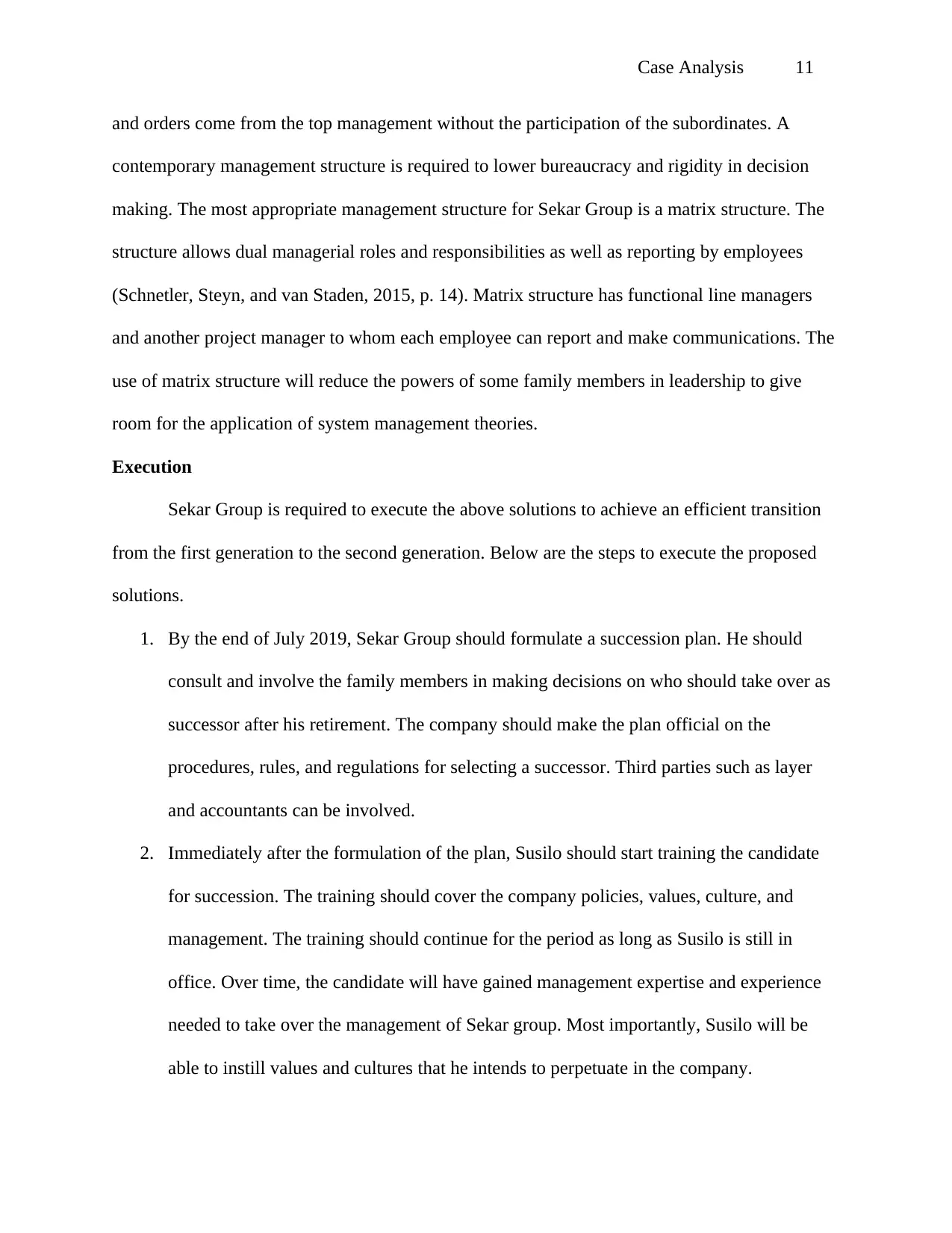
Case Analysis 11
and orders come from the top management without the participation of the subordinates. A
contemporary management structure is required to lower bureaucracy and rigidity in decision
making. The most appropriate management structure for Sekar Group is a matrix structure. The
structure allows dual managerial roles and responsibilities as well as reporting by employees
(Schnetler, Steyn, and van Staden, 2015, p. 14). Matrix structure has functional line managers
and another project manager to whom each employee can report and make communications. The
use of matrix structure will reduce the powers of some family members in leadership to give
room for the application of system management theories.
Execution
Sekar Group is required to execute the above solutions to achieve an efficient transition
from the first generation to the second generation. Below are the steps to execute the proposed
solutions.
1. By the end of July 2019, Sekar Group should formulate a succession plan. He should
consult and involve the family members in making decisions on who should take over as
successor after his retirement. The company should make the plan official on the
procedures, rules, and regulations for selecting a successor. Third parties such as layer
and accountants can be involved.
2. Immediately after the formulation of the plan, Susilo should start training the candidate
for succession. The training should cover the company policies, values, culture, and
management. The training should continue for the period as long as Susilo is still in
office. Over time, the candidate will have gained management expertise and experience
needed to take over the management of Sekar group. Most importantly, Susilo will be
able to instill values and cultures that he intends to perpetuate in the company.
and orders come from the top management without the participation of the subordinates. A
contemporary management structure is required to lower bureaucracy and rigidity in decision
making. The most appropriate management structure for Sekar Group is a matrix structure. The
structure allows dual managerial roles and responsibilities as well as reporting by employees
(Schnetler, Steyn, and van Staden, 2015, p. 14). Matrix structure has functional line managers
and another project manager to whom each employee can report and make communications. The
use of matrix structure will reduce the powers of some family members in leadership to give
room for the application of system management theories.
Execution
Sekar Group is required to execute the above solutions to achieve an efficient transition
from the first generation to the second generation. Below are the steps to execute the proposed
solutions.
1. By the end of July 2019, Sekar Group should formulate a succession plan. He should
consult and involve the family members in making decisions on who should take over as
successor after his retirement. The company should make the plan official on the
procedures, rules, and regulations for selecting a successor. Third parties such as layer
and accountants can be involved.
2. Immediately after the formulation of the plan, Susilo should start training the candidate
for succession. The training should cover the company policies, values, culture, and
management. The training should continue for the period as long as Susilo is still in
office. Over time, the candidate will have gained management expertise and experience
needed to take over the management of Sekar group. Most importantly, Susilo will be
able to instill values and cultures that he intends to perpetuate in the company.
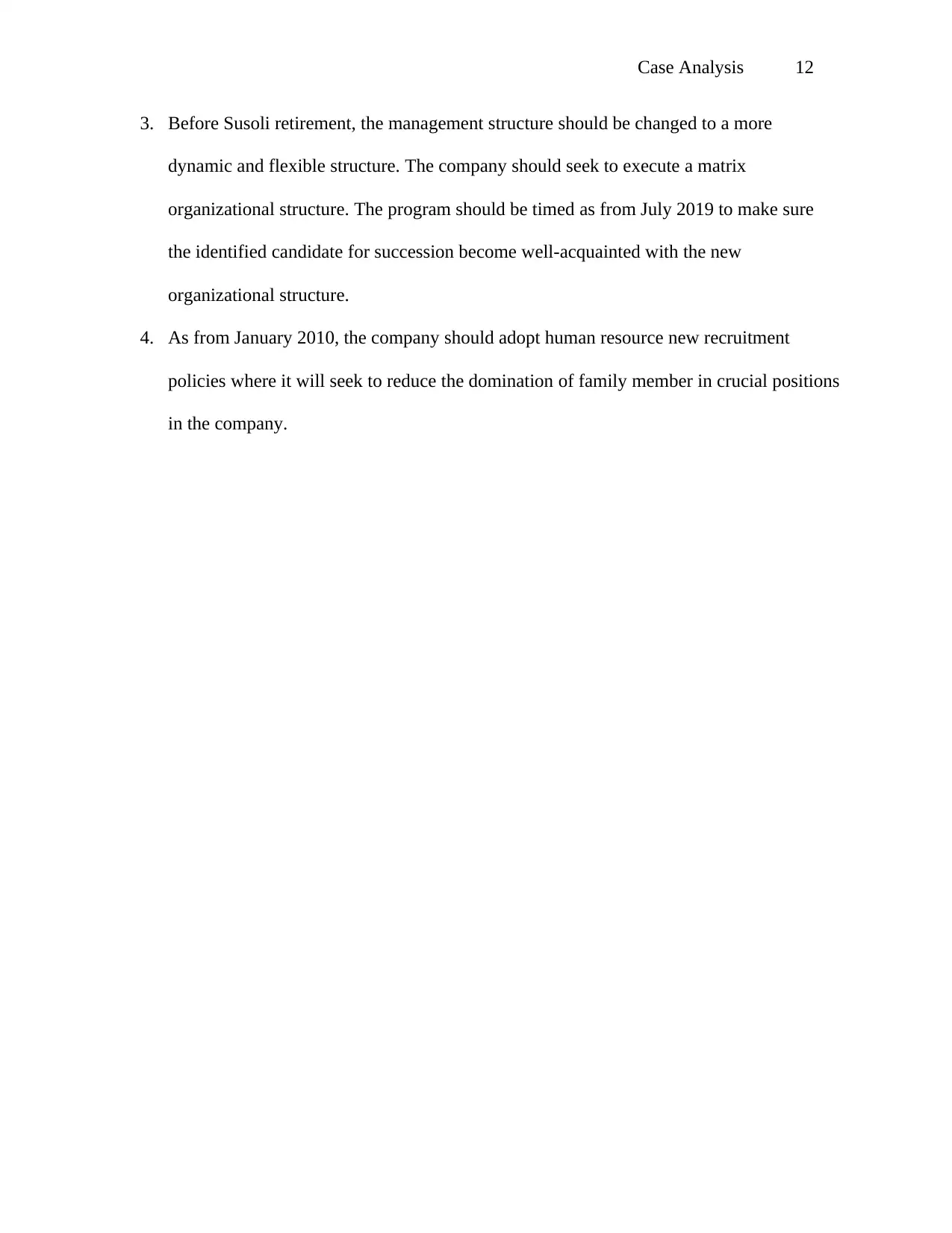
Case Analysis 12
3. Before Susoli retirement, the management structure should be changed to a more
dynamic and flexible structure. The company should seek to execute a matrix
organizational structure. The program should be timed as from July 2019 to make sure
the identified candidate for succession become well-acquainted with the new
organizational structure.
4. As from January 2010, the company should adopt human resource new recruitment
policies where it will seek to reduce the domination of family member in crucial positions
in the company.
3. Before Susoli retirement, the management structure should be changed to a more
dynamic and flexible structure. The company should seek to execute a matrix
organizational structure. The program should be timed as from July 2019 to make sure
the identified candidate for succession become well-acquainted with the new
organizational structure.
4. As from January 2010, the company should adopt human resource new recruitment
policies where it will seek to reduce the domination of family member in crucial positions
in the company.
⊘ This is a preview!⊘
Do you want full access?
Subscribe today to unlock all pages.

Trusted by 1+ million students worldwide
1 out of 14
Your All-in-One AI-Powered Toolkit for Academic Success.
+13062052269
info@desklib.com
Available 24*7 on WhatsApp / Email
![[object Object]](/_next/static/media/star-bottom.7253800d.svg)
Unlock your academic potential
Copyright © 2020–2025 A2Z Services. All Rights Reserved. Developed and managed by ZUCOL.


